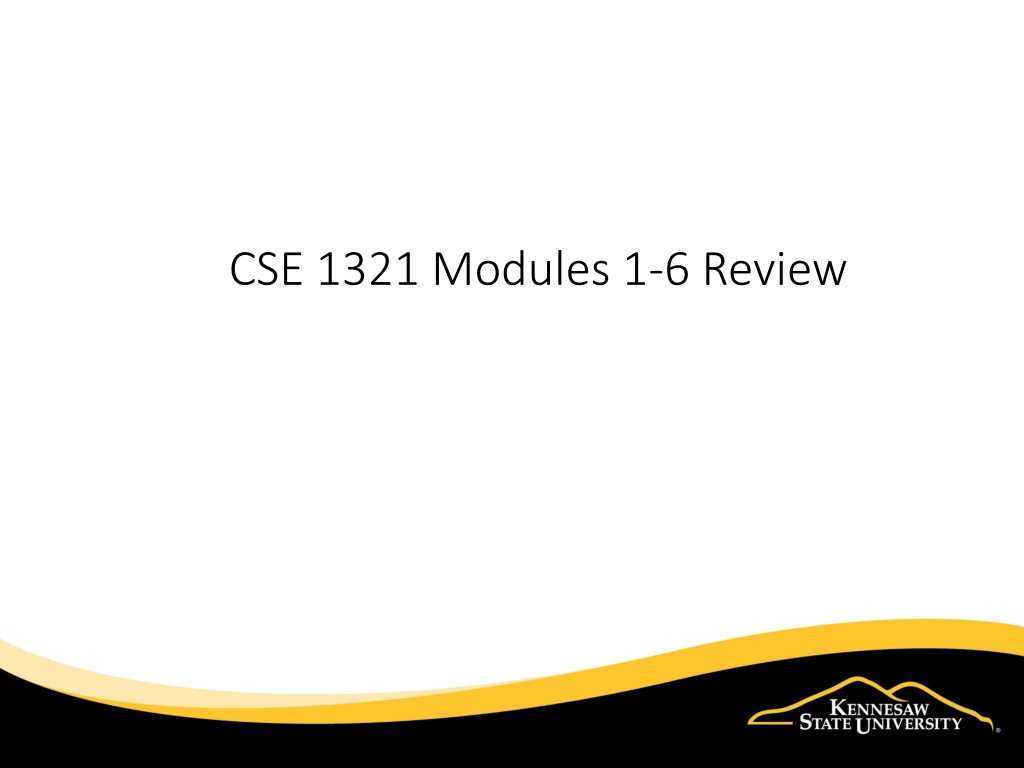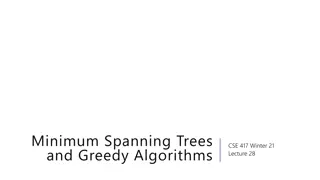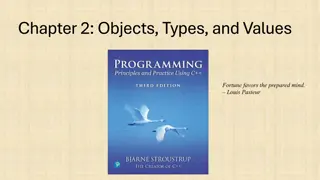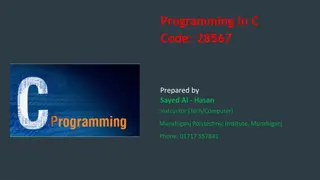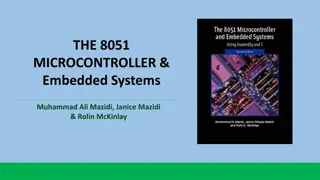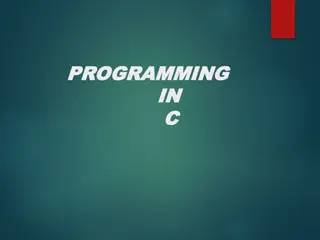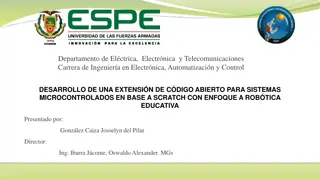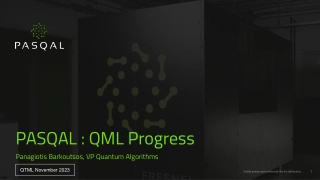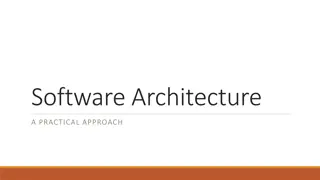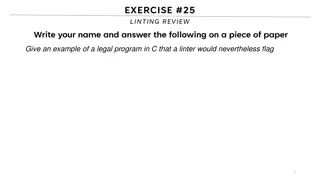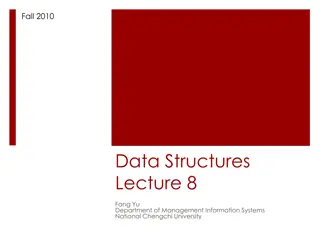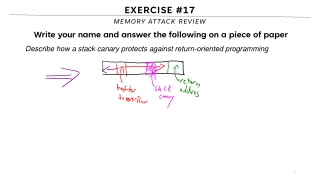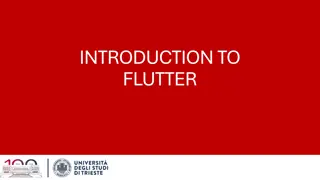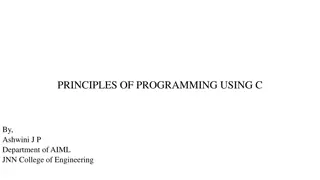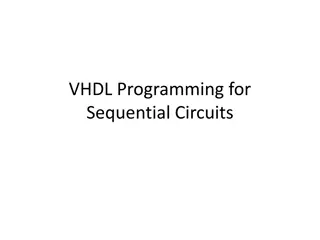Understanding Algorithms and Abstraction Concepts in Programming
Exploring algorithms as logical steps to accomplish tasks and abstraction as a way to group concepts for clarity in programming. Dive into flowcharts for sorting algorithms, pseudocode skeletons, and code snippets in various languages like C#, Java, and C++. Learn about handling variables and user inputs through pseudocode examples.
Download Presentation
Please find below an Image/Link to download the presentation.
The content on the website is provided AS IS for your information and personal use only. It may not be sold, licensed, or shared on other websites without obtaining consent from the author. Download presentation by click this link. If you encounter any issues during the download, it is possible that the publisher has removed the file from their server.
Presentation Transcript
Module 1 Algorithms and Abstraction Algorithms are: A set of logical steps to accomplish a specific task A set of direction/instructions Abstraction is: LOGICAL GROUPING of concepts or objects Hide the details (in functions or methods) We like to think at a high level of abstraction (no details) Too many details overwhelm us!
Algorithm in a Flowchart for Sorting Sample flowchart for a sorting algorithm. This flowchart illustrates the conditional constructs, loops, and other elements of control flow that comprise an algorithm for sorting, from smallest to largest, an arbitrary list of numbers (the algorithm is known as bubble sort ). In this type of diagram, arrows symbolize the flow of logic (control flow), rounded rectangles mark the start and end points, slanted parallelograms indicate I/O (e.g., a user-provided list), rectangles indicate specific subroutines or procedures (blocks of statements), and diamonds denote conditional constructs (branch points). Note that this sorting algorithm involves a pair of nested loops over the list size (blue and orange), meaning that the calculation cost will go as the square of the input size (here, an N-element list); this cost can be halved by adjusting the inner loop conditional to be , as the largest i elements will have already reached their final positions Image and Text from https://www.researchgate.net/figure/Sample-flowchart-for-a-sorting-algorithm- This-flowchart-illustrates-the-conditional_fig7_303337342
Ps Pseudocode Skeleton BEGIN MAIN END MAIN Note: every time you BEGIN something, you must END it! Write them as pairs!
C# Skeleton using System; class MainClass { public static void Main (string[] args) { } } Note: The opening { means BEGIN and the closing } means END
Java Skeleton class MainClass { public static void main (String[] args) { } } Note: Capitalization matters!
C++ Skeleton #include <iostream> int main () { return 0; }
Pseudocode Variables & Input Ps BEGIN MAIN CREATE inputNum PRINT( Please enter an Integer: ) inputNum = READ from user input END MAIN
C# Variables & Input using System; class main { public static void Main(String[] args) { Console.Write("Please enter an integer: "); int inputNum = Convert.ToInt16(Console.ReadLine()); } }
Java Variables & Input import java.util.Scanner; public class Main { public static void main(String[] args) { Scanner input = new Scanner(System.in); System.out.print("Please enter an integer: "); int inputNum = input.nextInt(); } }
C++ Variables & Input #include <iostream> #include <string> using namespace std; int main () { int inputNum = 0; cout << "Please enter an integer:"; cin >> inputNum; return 0; }
Escape Sequences Printing and escape sequence prints a special character in an output string. Common escape sequences: \b backspace. (e.g B\bsecz\bret prints what?) \t tab \n newline \r carriage return \ double quote \ single quote \\ backslash
Data Types 8 simple data types: 4 subsets of integers (int, long, short, byte) 2 subsets of floating point numbers (float and double) Character Boolean Complex Data Types: String Classes Arrays Objects
CONSTANTS and Literals CONSTANTS are values that cannot change while the program is running. E.g.: MAX_WEIGHT = 600 ELEVATOR_LIMIT = 10 * MAX_WEIGHT Literals are the values that are entered into the code: E.g. : ELEVATOR_LIMIT = 6000
Order of Precedence <>: also means not equal to
Shortcut Operators ++ increment by 1 (must be x++ or x ++, not x + +) -- += decrement by 1 (must be y-- or y --, not y - -) Add value on the right of the symbol to the variable on the left and store the result in the variable on the left. -= Subtract value on the right of the symbol from the variable on the left and store the result in the variable on the left. *= Multiply the variable on the left by the value on the right of the symbol and store the result in the variable /= Divide the variable on the left by the value on the right of the symbol and store the result in the variable %= the resulting remainder in the variable. Divide the variable on the left by the value on the right and store
Relational and Logical Operators Used to create a true or false expression: Relational: > greater than < less than == equals (note the double equals) != not equal (can also be <>) >= greater than or equal <= less than or equal Logical: Logical NOT (only works on one operand) Logical AND (requires two operands) Logical OR (requires two operands)
IF Statements Ps Builds on the Pseudocode from Slide 8 BEGIN MAIN CREATE inputNum PRINT( Please enter an Integer: ) inputNum = READ from user input IF (inputNum % 2 == 0) PRINTLINE( That number is even. ) END IF END MAIN
IF-ELSE Statements Ps Builds on the Pseudocode from Slide 18 BEGIN MAIN CREATE inputNum PRINT( Please enter an Integer: ) inputNum = READ from user input IF (inputNum % 2 == 0) PRINTLINE( That number is even. ) ELSE PRINTLINE( That number is odd. ) END IF END MAIN
IF-ELSE IF-ELSE Statements Ps Builds on the Pseudocode from Slide 19 BEGIN MAIN CREATE inputNum PRINT( Please enter an Integer: ) inputNum = READ from user input IF (inputNum == 0) PRINTLINE( That number is zero. ) ELSE IF (inputNum % 2 != 0) PRINTLINE( That number is odd. ) ELSE PRINTLINE( That number is even. ) END IF END MAIN
SWITCH/CASE Statements Different approach to the same problem (determining if a number is even or odd) Ps BEGIN MAIN CREATE inputNum PRINT( Please enter an Integer: ) inputNum = READ from user input SWITCH(inputNum % 2) CASE 0: PRINTLINE( That number is even. ) BREAK CASE 1: PRINTLINE( That number is odd. ) BREAK CASE default: ( You did not enter a number! ) BREAK END SWITCH END MAIN
In-Class Exercise Write a IF ELSE IF or SWITCH/CASE solution to the problem below: You have been tasked with writing the code to program an elevator for a skyscraper that is being built in Downtown Atlanta. Due to a new elevator design, there are no individual floor buttons, passengers simply press buttons to enter their desired floor (like inputting a PIN). In addition, there is no 13th floor and the top floor is 100. 1 2 3 4 5 6 7 8 9 CLOSE 0 OPEN
In-Class Exercise Solution BEGIN MAIN CREATE inputFloor PRINT( Please enter a floor using keypad: ) inputFloor = READ from user input SWITCH(inputFloor) CASE 1: PRINTLINE( Moving to 1stfloor. ) BREAK CASE 2: PRINTLINE( Moving to 2ndfloor. ) BREAK //skipped floors 3-98 leaving CASE 13 out CASE 99: PRINTLINE ( Moving to 99thfloor. ) BREAK CASE 100: PRINTLINE( Moving to 100thfloor. ) BREAK DEFAULT: PRINTLINE( Staying put, that floor does not exist ) BREAK END SWITCH END MAIN
WHILE Loops Repetition and Sentinel Ps Builds on the Pseudocode from Slide 20 BEGIN MAIN CREATE inputNum = 1 WHILE (inputNum >= 0) PRINT( Please enter an Integer: ) inputNum = READ from user input IF (inputNum == 0) PRINTLINE( That number is zero. ) ELSE IF (inputNum % 2 != 0) PRINTLINE( That number is odd. ) ELSE PRINTLINE( That number is even. ) END IF END WHILE END MAIN
DOWHILE Loops - Repetition and Sentinel Ps Builds on the Pseudocode from Slide 20 BEGIN MAIN CREATE inputNum = -1 DO PRINT( Please enter an Integer: ) inputNum = READ from user input IF (inputNum == 0) PRINTLINE( That number is zero. ) ELSE IF (inputNum % 2 != 0) PRINTLINE( That number is odd. ) ELSE PRINTLINE( That number is even. ) END IF WHILE (inputNum >= 0) END DO WHILE END MAIN
FOR Loops - Repetition Ps Builds on the Pseudocode from Slide 20 BEGIN MAIN CREATE inputNum PRINT( Please enter an Integer: ) inputNum = READ from user input FOR i is 0 to inputNum by 1 BEGIN FOR IF (i == 0) PRINTLINE(i + is zero. ) ELSE IF (inputNum % 2 != 0) PRINTLINE(i + is odd. ) ELSE PRINTLINE(i + is even. ) END IF END FOR END MAIN
In-Class Exercise Write a WHILE or DO WHILE solution to the problem below: You have been asked to update the elevator code to keep track of which floor the elevator is going to by incorporating a display which shows the next floor to be visited (only one floor can be entered at a time), the variable to display the next stop is called NextStop. Remember, there is no 13th floor and the top floor is 100. Next Stop: 1 2 3 4 5 6 7 8 9 CLOSE 0 OPEN
In-Class Exercise Solution BEGIN MAIN CREATE NextStop = 0 DO PRINT( Please enter a floor using keypad 0 to shut elevator down : ) NextStop = READ from user input SWITCH(NextStop) CASE 1: PRINTLINE( Moving to 1stfloor. ) NextStop = 1 BREAK //skipped floors 2-99 (13th is covered by default) CASE 100: PRINTLINE( Moving to 100thfloor. ) NextStop = 100 BREAK DEFAULT : PRINTLINE( Staying put, that floor does not exist! ) BREAK END SWITCH WHILE (NextStop > 0) END MAIN
Modules 5 & 6 - 1D Arrays Complex Data Type that: Holds several values of the same type Allows instant access by specifying an index number using brackets [ ] (remember to start at 0) Is linear Is static
1D Arrays - Creation Ps BEGIN MAIN CREATE INTEGER Stops[5] END MAIN
1D Arrays - Iteration Ps FOR each i in Stops from 0 to 4 by 1 PRINTLINE( Next Stop is: + Stops[i]) END FOR
1D Arrays In-class Exercise You have been asked to help a small movie theater create a program to track the ticket prices for the 100 seats in the theater for an upcoming blockbuster movie. Declare a 1D array that can hold 100 prices. Fill the first 20 values with $10 Fill the second 20 values with $20 Fill the third 20 values with $30 Fill the fourth 20 values with $40 Fill the last 20 values with $50
1D Arrays In-class Exercise BEGIN MAIN CREATE INTEGER Seats[100] FOR s is 0 to (length/size of Seats - 1) by 1 IF (s < 20) Seats[s] = 10 ELSE IF (s < 40) Seats[s] = 20 ELSE IF (s < 60) Seats[s] = 30 ELSE IF (s < 80) Seats[s] = 40 ELSE Seats[s] = 50 END FOR END MAIN
In-class Exercise Searching 1D For a special movie premiere event the theater held an auction and stored the bids in their seating array (1D array). They would like you to search through the array and find the highest bid so they know what it was. Hint: Use a linear search since the data is not sorted.
In-class Exercise Linear Search BEGIN MAIN CREATE maxBid maxBid = Seats[0] FOR each b in Seats from 1 to (Seats.length - 1) by 1 IF (Seats[b] > maxBid) maxBid = Seats[b] END IF END FOR PRINTLINE( Max bid was: + maxBid) END MAIN
Binary Search - Pseudocode Ps METHOD BinarySearch (parameters: array G, target) BEGIN low = 0, mid = 0, high = the number of elements in G WHILE (true) mid = (low + high) / 2 IF (target == G[mid]) RETURN true ELSE IF (target < G[mid]) ELSE ENDIF ENDIF IF (mid+1 >= high) RETURN false ENDIF ENDWHILE END BinarySearch high = mid low = mid
Bubble Sort - Pseudocode FOR each I from 0 to Length of A - 1 FOR each J from I+1 to Length of A I 1 IF (A[J] > A[J+1]) temp = A[J] A[J] = A[J+1] A[J+1] = temp END IF END FOR END FOR //Bubble sort compares adjacent elements and moves the larger value to the right. Ps
Selection Sort - Pseudocode FOR each I from 0 to n minPos = I FOR each J from I + 1 to n IF (B[j] < B[minPos]) minPos = J ENDIF ENDFOR IF (I != minPos AND minPos < n) temp = B[minPos] B[minPos] = B[I] B[I] = temp ENDIF ENDFOR Ps //Selection sort scans the array to find the smallest element and swaps it with the first element, then continues with the next position and so on. This creates a Sorted sub-array and an Unsorted sub-array, as each element is placed the Sorted sub-array grows, and the Unsorted sub-array shrinks.
Insertion Sort - Pseudocode FOR each index from 2 to n Ps key = A[index] position = index // Shift larger values to the right WHILE (position > 0 AND key < A[position-1]) A[position] = A[position - 1] position = position -1 ENDWHILE list [position] = key ENDFOR //Insertion sort works by inserting the next value to sort (it starts with the 2nd element) into its place. This creates a Sorted set (left side of array) and an Unsorted set, as each element is placed the Sorted set grows, and the Unsorted set shrinks.
Module 5 - 2D Arrays Ps Complex Data Type that: Holds several values of the same type Allows instant access by specifying a index number using brackets [][] or [ , ](remember to start at 0) Is linear Is static
2D Arrays - Creation Ps BEGIN MAIN CREATE INTEGER Stops[5][5] END MAIN //Willy Wonka elevator that can go 8 directions
2D Arrays - Iteration Ps Use nested loops to iterate through a 2D array FOR each r in ROW from 0 to 4 by 1 FOR each c in COLUMNS from 0 to 4 by 1 PRINTLINE( Next Stop is: + Stops[r][c]) END FOR END FOR
2D Arrays In-class Exercise You have been asked to help a small movie theater revise the program to track the ticket prices for the 100 seats in the theater for an upcoming blockbuster movie. Declare a 2D array that can hold 100 prices. Fill the rows one and two with $10 Fill rows three and four with $20 Fill rows five and six with $30 Fill row seven and eight with $40 Fill the rows nine and ten with $50
2D Arrays In-class Exercise BEGIN MAIN CREATE INTEGERS Seats[10][10] FOR R in ROWS from 0 to (length of ROWS - 1) by 1 FOR C in COLS from 0 to (length of COLS - 1) by 1 IF (R == 0 OR 1) Seats[R][C] = 10 ELSE IF (R == 2 OR 3) Seats[R][C] = 20 ELSE IF (R == 4 OR 5) Seats[R][C] = 30 ELSE IF (R == 6 OR 7) Seats[R][C] = 40 ELSE Seats[R][C] = 50 END FOR END FOR END MAIN
In-class Exercise Searching 2D The theater has asked you to write a program that allows a user to select a seat from the seating array (2D array). They would like it to search through the array by price to find the first available seat at that price point. Hint: Use a linear search since it is a 2D array.
In-class Exercise Searching 2D BEGIN METHOD findSeat(CREATE price) FOR each row in Seats from 0 to 9 by 1 FOR each col in Seats from 0 to 9 by 1 IF (Seats[row][col] == price) RETURN The seat at + [row] + , + [col] + is available for $ + price END IF END FOR END FOR END METHOD
In-class Exercise Searching 2D BEGIN MAIN CREATE price PRINT ( Please enter price for seat: ) READ price PRINTLINE(findSeat(price)) END MAIN
End of Review Questions?
